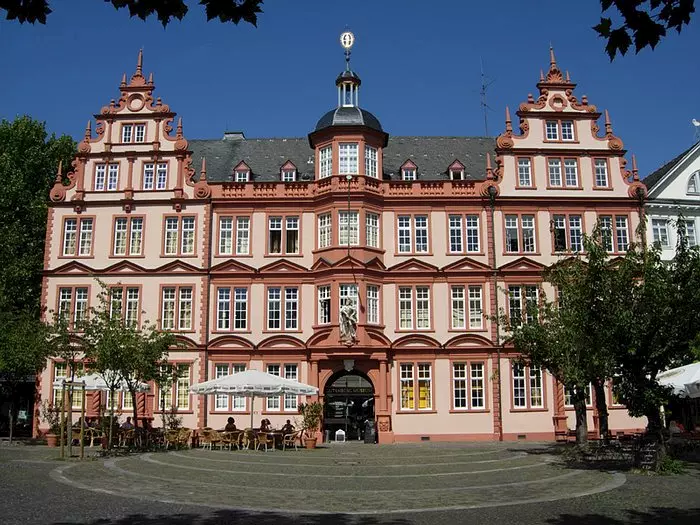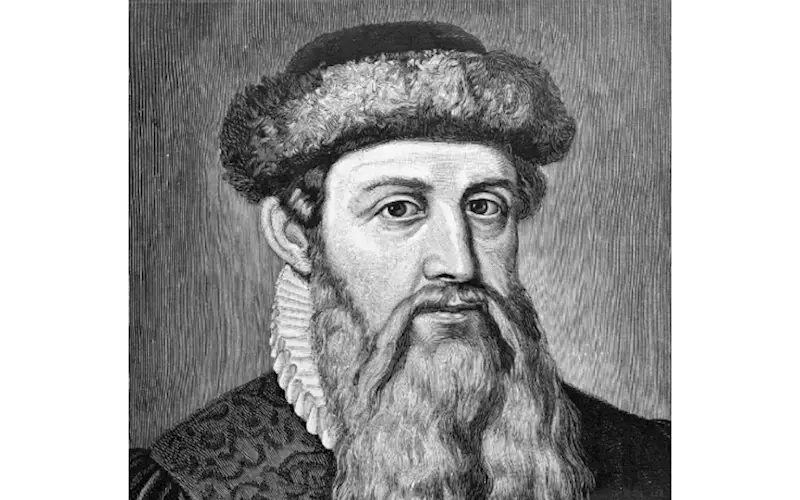So, who exactly was Gutenberg then?
Printer’s Day in India is 24 February. This is the day the All India Federation of Master Printers and its affiliate associations celebrate as Gutenberg’s “birthday”. PrintWeek looks at the man, the machine and the myth — and tries to unravel why we owe him our gratitude.
24 Feb 2020 | By Noel D'Cunha
Q: Please remind me, who was Gutenberg?
Johannes Gutenberg (full name Johannes Gensfleisch zur Laden zum Gutenberg).
Q: Was he a printer?
Nope.
Q: Was he a wordsmith?
Nope, again.
Q: Who was he then?
Gutenberg was a businessman, doing quite well out of making mirrors, who saw printing as a means of enriching himself even more. A bit like William Caxton.
Q: Now who is this Caxton?
William Caxton would move from diplomacy and cloth trading in Bruges to set up his Westminster press 30 years later.
Q: But wasn't some of the technology already available in China and Egypt before Gutenberg and Caxton came on the scene?
Well, yes. But Gutenberg is the first European to develop a mass production method for casting movable metal type which could be composited into printable pages and re-used afterward.
Q: Didn't Gutenberg steal the idea?
Hmm. That's harsh. His printing press was a simple adaptation of the appliance the Romans had used for turning grapes into wine and olives into oil. The highly skilled craft of making the steel punches with which images could be cut for impression on coins also dated back to ancient times. Gutenberg's genius lay in seeing how these and other devices could be combined into an invention that would revolutionise the world.
Q: I see in that case what is the screw press?
Well, the movable metal type was accompanied by the creation of an oil-based ink for paper or vellum, and the adaption of the screw-press into an efficient printing machine.
Q: When did this happen?
They say Gutenberg's first press was set up in his home town of Mainz in 1440.

Gutenberg Museum in Mainz opened in 1962
Q: Why do you say, ‘they’ say?
This has been challenged by a German scholar in recent years, Strasbourg being nominated instead.
Q: What are you saying, man! So Gutenberg was not the inventor?
Behave! Stop behaving like Arnab!
Q: Which print collateral did Gutenberg print?
It was 1448 in Mainz. It was there that he produced his first book, a Latin primer.
Q: What was it called?
The Gutenberg Bible, with double-columned pages 42 lines deep.
Q: Describe it.
The Gutenberg Bible was created out of perfect proportion, a typographical version of the golden section that the Greeks first hit upon for the Parthenon. There were 300 such punches, with each steel-engraved letter and every type cast from it, and every line made up from those letters, made and set to an accuracy measured in hundredths of a millimetre.
Q: Didn't the Koreans and Dutch beat Herr G in the print race?
While there are arguments about Korean and Dutch predecessors, Gutenberg’s complete ‘workflow’ was the true beginning of the global printing industry.
Q: So, thanks to Gutenberg, print spread?
Yup! Printing spreads rapidly throughout Europe and became an information-spreading factor in both the religious Reformation and the cultural European Renaissance. Early printers such as Christopher Plantin, Aldus Manutius and Claude Garamond, worked to improve the formatting of books and the legibility of type.
Q: In which case, what happened to Gutenberg’s Gothic black letter calligraphy copies?
The Gutenberg-style hand-pulled wooden ‘Common Press’ was to remain unchanged until the adoption of cast iron and mechanisation in the 1800s.
Q: And Mainz was the centre of the print universe?
Not really. Within a dozen years of Gutenberg's death, no fewer than 122 towns across Europe had printing presses. And so, the balance of creative power was shifting from Germany to Italy, where the dominance of Gothic type was ended and Venice became the continent's printing capital.
Q: Here shouldn't we talk about the Chinese geniuses who wrote on grains of rice?
We should but the method of casting letters is equally kool.
Q: How so? It's basically an alloy being melted. Right?
Hmm. Gutenberg’s workshop invented an ingenious matrix that could hold a letter blank made out of hardened metal, and quick-cooling lead could be poured within to make a single letter form.
Q: And Gutenberg did this solo?
There was Johann Fust: a tradesman trained in goldsmithing, as was his brother, who in Mainz was also a goldsmith and burgermeister (and, head of the metal smithing guilds).
Q: He was Gutenberg's sidekick?
Nope. Gutenberg needed capital to invest in development of his new invention, and Johann Fust was willing, even borrowing money to lend to the undertaking.
Q: So it should be called the Fust and Gutenberg Bible?
Also Peter Schoeffer. It was Fust, Gutenberg, and Schoeffer’s tenuous collaboration that culminates in the Gutenberg Bible.

Gutenberg Bible old testament
Q: It's getting too confusing. Who is this Peter fellow, now?He was a scribe and a copyist of texts. He gives up his creative job to become an apprentice of Gutenberg who was a very tough taskmaster.
Q: Why so?
Because Peter Schoeffer's adopted father is ... (please hold your breath) ... none other than merchant-investor Johann Fust, who needed backup at close hand to manage the mercurial Gutenberg.
Q: Ouch. This sounds like a Balaji TV serial soap opera.
Yes, allegiances, among the three key players shifted; a shroud of secrecy weighed heavily on everyone.
Q: Fulltooo drama?
Outside the Church was watching. Inside the Mainz workshop there was... financial setbacks, raids, destruction, betrayals, and endless resetting of vellum pages — at great expense.
Q: And how do you know all this?
We know this because Fust sued Gutenberg, and the records of that trial exist. We know that Fust and Schoeffer opened a famous print house afterward, and that Schoeffer went on to become one of the most famous printers of incunabula.
Q: Humara Peter?
Yup. There is more.
Q: There is more?
We know that Peter Schoeffer married Fust’s daughter.
Q: But Fust was his father?
Yes, kahaani mein twist!
Q: Why did Fust permit his daughter to marry his foster son?
Often, this is used as the reason to explain why Peter “betrayed” Gutenberg.
Q: Peter betrayed Gutenberg?
Ja. Ja. People were well advised to admire Peter's talent and watch their backs.
Q: What was Peter's talent?
Many talents. But he introduced typography and hand-wrought craftsmanship in the workshop.
Q: Once again, I ask, humara Peter?
Yup!
Q: Hard to imagine!
Do try to understand there were no letters that we would call “lower-case” (a term derived later, from the printing industry that these men helped create). The small letterforms we accept today as ubiquitous to western literacy as leaves or grass are to nature were derived from uncial forms scribes developed. Upper-case Roman lettering was taken from the great inscribed letters from Ancient Rome. Marrying them together was a later invention.
Q: Describe a scene from Gutenberg's workshop to me.
In this scene, Gutenberg and Schoeffer pull a proof set with some newly designed type:
“Fiat imprimere!” the master cried, and they hauled back the bed. Peter opened up the wooden frame. Carefully he peeled off the sheet, as the others stepped back to a respectful distance.
A power surged out of those words, a strength that even Peter had not pictured. The ink was as black as heaven’s vault, the letters sharp and gripping. They wove into a trellis just as Pliny said all lines must do, to hold the meaning of the text like wires among the vines. The Word is as a fruit, he thought; the vineyard of the text is thickly twined. He started, transfixed. In their austerity and density, the letters made a page of extraordinary beauty. His letters — his! — the very lines he’d drawn and carved, now lay proudly, blackly, making words up on the page. He felt his insides quicken with the thrill of it — and then a kind of falling.
Gutenberg was fairly hopping just behind him. Peter felt his energy and eagerness, and from the corner of his eye he saw him reaching. Peter held the page out to him, his fingers grazing the deep bite of the words had taken in it.
“By God!” The master’s face was open, softened, every trace of sharpness gone. “A scribe, my eye! A bloody carving genius, more like! From here on out you sculpt my types.”
POSTSCRIPT
So what is The Gutenberg Galaxy?
The Gutenberg Galaxy is a collection of case studies in print advertising. Ashish Bhasin, chairman and CEO, Dentsu Aegis Network, South Asia launched it exactly one year ago in Mumbai during February 2018.
Who is Ashish Bhasin? Is he related to Gutenberg?
Nope. Bhasin is the chairperson of the Media Research Users Council that brings out the IRS, which is the largest readership survey in the world. During the launch Ashish Bhasin “urged print media owners to play to their strength and not the weakness. He said print was the most credible medium and would come out stronger once the dust settles.
All that is fine, but do the numbers add up?
Throwing some numbers to strengthen the case, between now and 2025, 300 million potential readers would come into the fold. And our calculation indicates that the next seven years will see a print constituency in India's tier two, three and four cities. All thanks to three gentlemen. Gutenberg, Fust, and Schoeffer.














 See All
See All